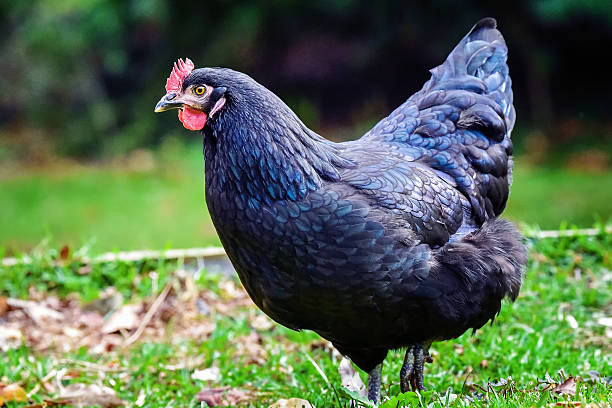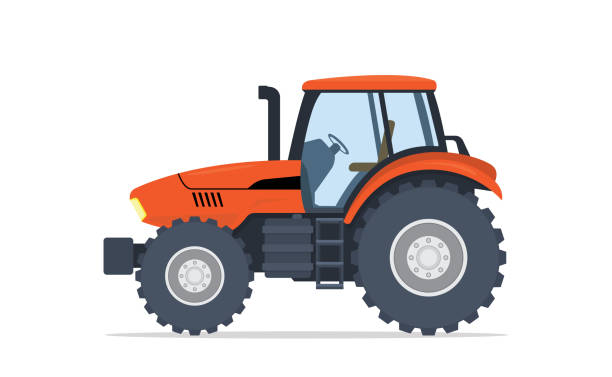Understanding the Blue Chicken Breed
Origins and History
Blue Chickens are synonymous with beautiful colored birds that have a bluish-gray color most often and they have an interesting story to tell. They are not a naturally occurring breed but are selectively-bred birds with special characteristics in egg-laying and feather tones. These breeds have, in the past, been developed through crosses between recognized varieties that have some degree of blue coloration, a factor arising from the interactions of recessive genes.
Physical and Behavioral Characteristics
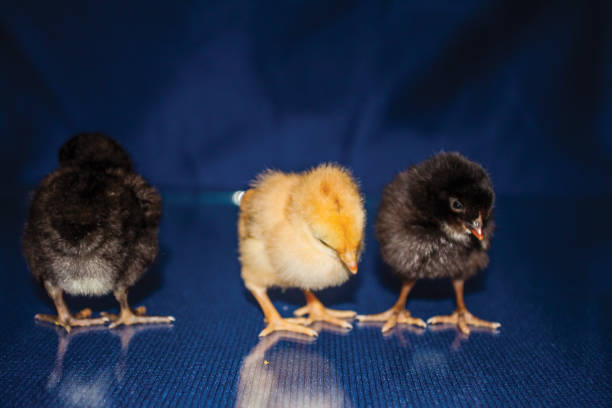
Blue Chickens exhibit a robust build with dense, soft plumage and a friendly disposition. Their calm and docile nature makes them a favorite not only among farmers but also as backyard pets. This breed also exhibits adaptability to various climates and environments, although extreme conditions can impact their well-being.
Lifespan
The lifespan of Production Blue chickens generally falls within the range of 5 to 10 years. Several factors can affect their longevity, including:
- Diet:Healthy and normal diet is more nourishing and improves the health and life span of an individual.
- Housing:A clean, safe, comfortable home can do much to reduce stress, and prevent disease in an individual.
- Healthcare:Vaccination of animals, proper feeding, and also periodic health check-ups form part of the procedure of extending the life span of the animal.
- Predator Protection: This is important as it minimizes the number of cases of injuries among the young animals, and reduces stress which decreases their life span.
Production blue chicken Personality
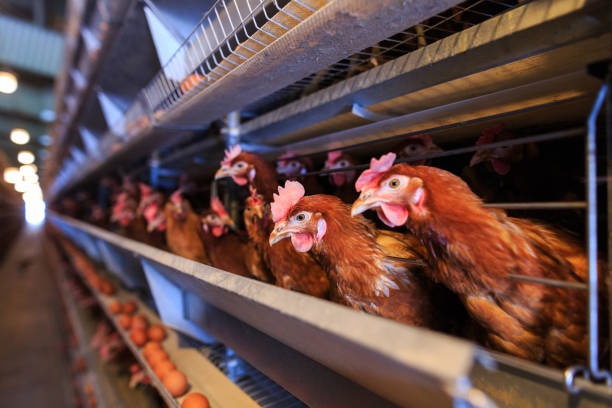
The Production Blue chicken is a breed developed primarily for its meat production, known for its unique characteristics and friendly disposition.
Characteristics:
- Appearance: Production Blues are medium to large-sized birds with a distinctive blue or gray feather color. They often have a robust body and a prominent breast, which enhances their meat quality.
- Productivity: As a dual-purpose breed, they are valued for both egg production and meat. They tend to have good laying capabilities, providing medium-sized brown eggs.
- Temperament: Generally, Production Blues are known for their calm and friendly personalities. They are typically social and easy to handle, making them a popular choice among backyard chicken keepers.
Care and Handling:
Production Blues thrive in varied environments but require adequate space to roam and forage. Their sociable nature makes them suitable for mixed flocks, and they adapt well to human interaction.
In summary, the Production Blue chicken offers a combination of appealing physical characteristics, productive qualities, and a pleasant temperament, making them a favorite for small farms and hobbyists.
Production Blue Hen Vs Rooster

When comparing a Production Blue Hen to a Rooster, it’s important to clarify what you’re specifically interested in, as these categories refer to different aspects of poultry.
-
Production Blue Hen:
- The term “Production Blue Hen” generally refers to a type of chicken bred for high egg production. They are often hybrids designed to be efficient layers, and the name might be used to describe chickens with blue or gray plumage in a production setting.
- These hens are known for their ability to lay a high number of eggs and are valued in farming for their productivity. Characteristics might include calm temperament, hardiness, and a focus on egg size and frequency.
-
Rooster:
- A rooster is a mature male bird which scientifically is a type of the chicken. We recognize them as animals that are used in breeding, in the protection of flocks, and we associate them with crowing. The male birds, the roosters, are usually ‘larger’ than the females, have heavier combs and wattles and may have brighter or more elaborate feathers.
- Roosters for their part do not lay eggs but are useful in a flock mainly for breeding and defending the flock. They may be aggressive to humans and other birds in order to keep up the flock.
Key Differences:
- Purpose: Hens, like the Production Blue, are primarily kept for egg production. Roosters are kept for breeding and protection.
- Physical Characteristics: Cocks are usually bigger and have more bright feathers, they also tend to be a lot more territorial as compared to hens. This might not hold so if the hens are of a particular bred selected for specified character traits.
- Behavior: Production hens are generally bred for calmness and efficiency in laying, while roosters may display more dominant behaviors.
Production blue chicken temperament
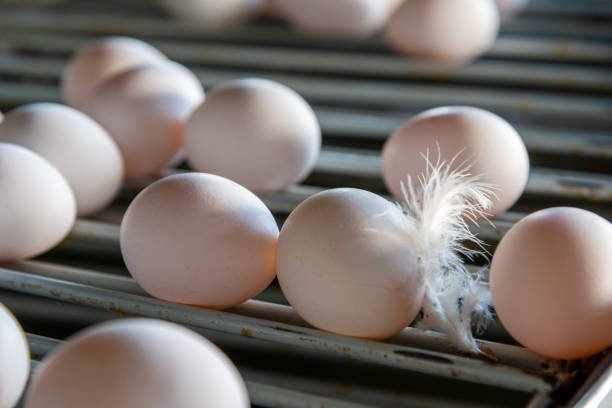
Annual Egg Yield
It is widely used as a commercial egg layer, producing an average of 250 – 280 eggs per annum. This productivity puts them in to par with other elite layer breeds, and thus are ideal for both commercial and backyard production.
Unique Egg Colors and Market Appeal
Beyond quantity, Blue Chickens are known for laying eggs in intriguing shades. Though typically light brown, some individual birds lay eggs with a tinted hue, adding to their market appeal. Their eggs are not just a source of nutrition but a unique product that stands out in boutique markets, catering to consumers seeking something special.
Breeding Blue Chickens
Selective Breeding and Genetic Diversity
The process of developing Blue Chickens involves careful selective breeding to enhance specific traits while maintaining genetic diversity. This diversity is crucial for preventing health issues and ensuring the longevity of beneficial characteristics like high egg yield and vibrant plumage.
Challenges in Breeding
According to the different types of challenges that breeders encounter in the process of selecting animals for breeding and maintaining the balance between the optimal characteristics and genetic health of inherited properties, the list of the challenges is as follows. Blue color is inheritable but the recessive genes are somewhat challenging to handle and mastery in breeding is needed.
Feeding and Nutrition
Optimizing Dietary Requirements
Protein, vitamins and mineral are the food classes most important for the health and production of Blue Chickens. Extra calcium is also vital to meet the demands of their prolific laying system they possess.
Common Feeding Mistakes
A farmer must keep off from a range of restrictive diets that may have negative impacts on his/her health such weak protein diets or energy rich diets that may make him/her weaken and be less productive.
Housing and Environment
Ideal Coop Conditions
Hygiene and proper condition of the blue chickens home that should be spacious and safe from natural enemies are very important to these birds. The temperature change and space provision are the main conditions that allow reducing the level of stress and, therefore, the occurrence of diseases.
Health and Wellness
Common Health Issues and Preventative Care
Like any other poultry, Blue Chickens are also exposed to diseases that affect respiratory system and parasites. That is why it is important to conduct scheduled checkups and prevention measures that include vaccinations and sanitary measures regarding the flock.
Veterinary Support
Getting veterinary services right time makes it easy to prevent the would be problems from arising, and the wellbeing of the flock is well checked.
Blue Chickens as Pets
Popularity and Care Tips
In this regard, Blue Chickens are friendly and as a result are the most sought after birds by bird lovers. As pets making sure that they spend most of their time in clean and stimulating environment with lots of interaction with other animals is very important.
Economic Impact and Sustainability
Small Farm Benefits and Market Demand
For small farms, Blue Chickens offer economic benefits through high egg production and the unique allure of their appearance and egg coloration. As consumer interest grows, the demand for Blue Chickens is on the rise, providing a profitable niche market.
Sustainability Practices
By 2024, environmental friendly production including waste management, utilization of resources in production and farming organically help the Blue Chicken production to make as small impact on the environment as possible.
Future Trends in Blue Chicken Production
Technological Innovations
Regarding technological issues, progressive improvements in breeding technologies, and farm management are expected to improve production and to promote reduced negative effects on the environment. Genetic tracking and automatic feeders are such integrated technologies, which are becoming more and more common.
Global Market Expansion
The global interest in unique poultry breeds is driving expansion opportunities beyond traditional markets. The appeal of Blue Chickens as both producers of specialty eggs and ornamental birds is leading to increased international trade.
Conclusion
The movie of the Blue Chickens in 2024 is a thematic combination of the company’s tradition and the further innovations, based on the principles of sustainable development. The appearance and utility of this rare breed occupy a middle ground which, as farmers and aficionados continue to engage with Blue Chickens, offers potential for business-savvy smallholders and large-scale commercial farms.
Frequently Asked Questions
What is a Blue Production Chicken?
A Blue Production Chicken is a high-yielding breed known for its excellent egg quality and egg-laying ability. These chickens are recognized for their distinctive blue color and pattern, making them valuable additions to breeding programs, small farms, and backyards.
How many eggs do Blue Production Chickens lay per year?
Blue Production Chickens are known for their impressive egg production capabilities, typically laying between 250 to 300 eggs per year.
What makes Blue Production Chickens different from other breeds?
Blue Production Chickens stand out due to their unique blue coloration, high egg yield, and adaptability to different temperatures. These traits make them popular among both farmers and bird enthusiasts.
What colors do Blue Production Chicken eggs come in?
The eggs of Blue Production Chickens can vary in color, ranging from blue to bluish-green. The unique and attractive colors make these eggs appealing in the market.
Are Blue Production Chickens suitable as pets?
Yes, Blue Production Chickens have gained popularity as pets among bird lovers due to their friendly behavior, adaptability, and consistent egg production.
What are the dietary requirements for Blue Production Chickens?
Blue Production Chickens require a balanced diet that includes a mix of grains, proteins, vitamins, and minerals. Nutritional supplements can be added to ensure optimal health and egg production.
What are some common health issues in Blue Production Chickens?
Like other chicken breeds, Blue Production Chickens can be prone to health issues such as respiratory infections, parasites, and nutritional deficiencies. Regular preventative care and veterinary support are essential to maintain their health.
What are the benefits of raising Blue Production Chickens for small farms?
Raising Blue Production Chickens can be highly beneficial for small farms due to their high egg yield, unique egg colors, and adaptability to various environments. These chickens can also attract niche markets, increasing the farm’s profitability.


